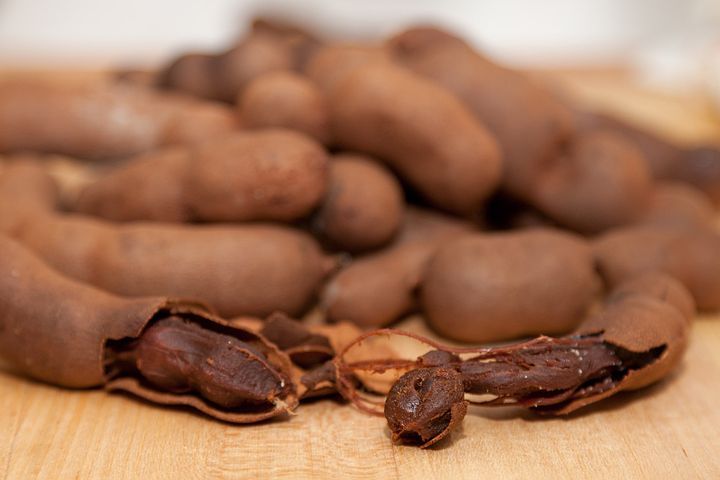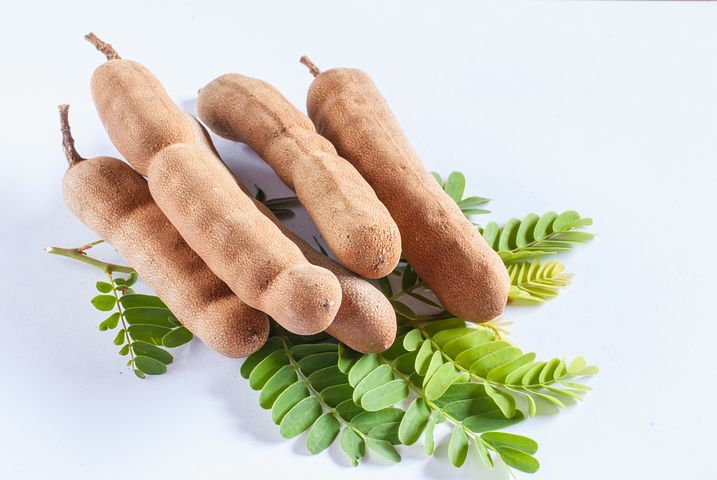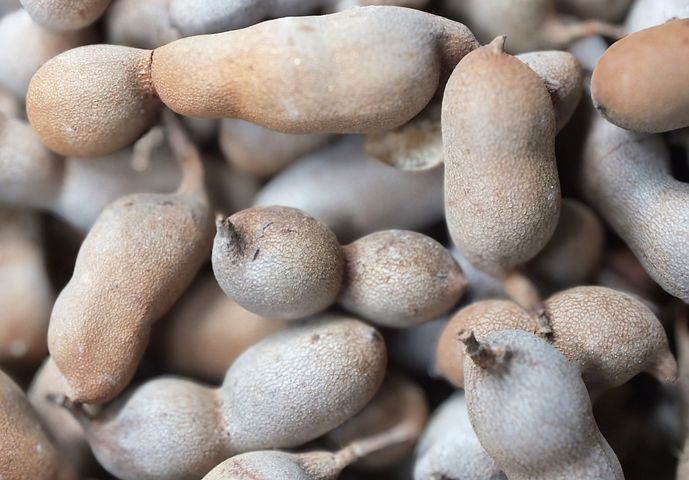The popular tamarind fruit.
Today I decided to come up with a FAQ on tamarind, and to give a brief explanation on it based on my research. I hope it will be helpful for you.
The popular tamarind fruit.
Tamarind is a fruit that comes from the tamarind tree, which is mostly found in Africa but also grows in many other regions of the world, apart from Africa. The fruit is brown in colour and has a sweet and sour taste.
Tamarind is a good source of nutrients, which includes vitamin C, potassium, magnesium, and iron. It is also high in fiber and antioxidants. The pulp of the fruit is often used to make tamarind paste, which are mostly use in drinks, in my country Nigeria.

source: pixabay
Tamarind which is also known as tsamia in Hausa, is mostly used for its health benefits, which includes aiding digestion, reducing inflammation, lowering cholesterol, and improving cardiovascular health. It is also believed that it may help fight infections.
My mom normally takes tamarind, and when I asked, she said it helps in treating constipation, fever, and rheumatism. She also added, it is not an ideal substitute for medical treatment, but it can help treat some of these ailments.
Where does tamarind grows more?
Tamarind trees are mostly grown in Africa but are now widely cultivated in other countries of the world, including Asia, South America, and parts of the Middle East.
In Asia, tamarind is commonly grown in India, Thailand, Malaysia, and Indonesia. In South America, it is grown in countries such as Mexico, Guatemala, and Brazil. The fruit can also be found in other parts of the world, like Australia.
What is it used for?
The tamarind fruit has a lot of uses, ranging from culinary to medicinal uses. Some of the uses are listed below;
Culinary use: Tamarind is a popular ingredient in many cuisines, especially in Asia. The pulp of the fruit is often used to make tamarind paste, which are commonly used in sauces, chutneys, marinades, and drinks. It can also be used in desserts, such as tamarind candy and tamarind ice cream.
Medicinal use: Just as I have mentioned before, it is used for treatment of some ailments, and it's mostly eaten because of it health benefits. Some of these ailments which I've mentioned are fever, rheumatism and constipation. It helps in fighting infections. Tamarind is also known to aid digestion, reduce inflammation, lower cholesterol, and improve cardiovascular health ( I already mentioned this)
Industrial use: Tamarind is used in the industrial production of textiles, paper, and adhesives. The seed of the fruit contains a polysaccharide called xyloglucan, which is used as a stabilizer in the food industry and as a thickener in the textile industry. I have entered a section where only the chemistry students, mostly likely those who studied macromolecular/polymer chemistry will understand.
Cosmetics use: Tamarind is used in some cosmetic products, such as skin creams, due to its antioxidant and exfoliating properties.
That's all for some of the uses. I'm sure we have more of it uses but we'll stick to this for now.

source: pixabay
Tamarind in Nigeria
Tamarind is grown and consumed in Nigeria, particularly in the northern parts of the country. In Nigeria, tamarind is known as "tsamia" in Hausa language, which is the most widely spoken language in the northern region of the country.
Tamarind is commonly used in Nigerian cuisine to add a sour flavour to dishes. It is often used in stews, sauces, and as well as in refreshing drinks and snacks. Tamarind is also used in traditional medicine in Nigeria to treat various ailments, such as diarrhea and dysentery.
In Nigeria, tamarind is also a popular ingredient in the production of "zobo," a popular drink made from hibiscus flowers, ginger, and tamarind. The drink is typically served chilled and is a popular refreshment during hot weather. People believe that zobo is one of the best locally made drinks in my country. Well I don't know yet.

source: pixabay
Uses of tamarind in Nigeria
Tamarind, which I said is also known as "tsamia" in Hausa language, is a popular ingredient in Nigerian, with lots of uses. Here are some of it uses in Nigeria:
Medicinal use: Tamarind is used in traditional medicine in Nigeria to treat various ailments, such as diarrhea and dysentery. It is also believed to have antimicrobial properties and may help fight infections.
Cosmetics use: Tamarind is also used in Nigeria for some cosmetic products due to its antioxidant properties.
Fuel use: The dried shells of the tamarind fruit can be used as a fuel source for cooking and heating. We gather them and use them to aid burning fire.
Tamarind is an important ingredient in Nigerian culture and cuisine, and has lots of uses and benefits that are well utilized in various industries and applications.
How do people use tamarind in kunu
Kunu is a popular Nigerian drink made from millet or sorghum, and it is often flavoured with spices and other ingredients, such as tamarind. Here's how tamarind is used in kunu:
Tamarind pulp preparation: The tamarind fruit is first soaked in hot water to soften the pulp. The pulp is then separated from the seeds and fibers.
Mixing with other ingredients: The tamarind pulp is mixed with other ingredients such as millet or sorghum, ginger, sugar, and other spices.
Fermentation: The mixture is allowed to ferment for a period of time, which can range from several hours to a day or more.
Straining: Once the mixture has fermented, it is strained to remove any remaining seeds or fibers. People here will say filter.
Serving: The finished kunu is typically served cold. You'll enjoy this after a long hot day.
The addition of tamarind to kunu gives the drink a sour flavour that balances well with the sweetness of the other ingredients. The tamarind also adds a unique depth of flavour to the drink that is enjoyable.

source: pixabay
The use of tamarind in kunun geda
Kunun geda is a popular Nigerian drink that is made from groundnuts and white rice, and it is often flavoured with spices and other ingredients, such as tamarind. Here's how tamarind is typically used in kunun geda:
Tamarind pulp preparation: The tamarind fruit is first soaked in hot water to soften the pulp. The pulp is then separated from the seeds and fibers. Just like the process I mentioned above.
Mixing with other ingredients: The tamarind pulp is mixed with other ingredients.
Blending: The mixture is blended together to create a smooth and creamy consistency. The ingredients are ginger and others may include sugar.
Straining: Once the mixture has been blended, it is strained to remove any remaining seeds or fibers. Now the mixture is being added to the already prepared kunun geda.
Serving: The finished kunun geda is normally served hot. It is also a roadside drink..... It blends well with masa (a roadside food) or akara (another roadside snack/food).
The addition of tamarind (tsamia) to kunun geda gives the drink a sour taste that balances well with the sweetness of the drink.
The leaves of tamarind for soup in Nigeria
In Nigeria, tamarind leaves are sometimes used in traditional cooking, particularly in the northern regions of the country. I once tasted the soup my mom made using tamarind leaves.... O boy!!!! It was delicious. I loved it.
Let's see how it's been made;
Harvesting the leaves: Tamarind leaves are harvested from the tamarind tree and washed to remove any dirt.
Preparing the soup: The soup is prepared using a combination of vegetables, spices, and meat. We add enough chilli to it.
Adding the tamarind leaves: Once the soup is heating, the tamarind leaves are added to the pot, and the soup is allowed to continue cooking until the leaves are soft.
Serving: The finished soup is served hot with tuwon masara, tuwon shinkafa or eba.
Tamarind leaves are believed to have health benefits, such as being high in antioxidants and anti-inflammatory compounds.

source: pixabay
The nutritional value of tamarind
Tamarind is a nutrient-dense fruit that gives a range of vitamins, minerals, and other beneficial compounds.
Here are some of the key nutritional components of tamarind:
Fiber: Tamarind is a good source of dietary fiber, which can help support digestive health.
Vitamin C: Tamarind is a good source of vitamin C, which is an important antioxidant that helps protect cells from damage and supports immune system function.
Potassium: Tamarind contains potassium, an essential mineral that is important for maintaining healthy blood pressure and regulating fluid balance in the body.
Magnesium: Tamarind is a good source of magnesium, which is important for maintaining healthy bone density, supporting muscle and nerves function, and regulating our heart beat.
Iron: Tamarind contains iron, which is important for healthy blood cell production and energy metabolism.
B Vitamins: Tamarind contains several B vitamins, including thiamin, Vitamin B, niacin, and folate, which play important roles in energy production and other cellular functions.
Tamarind is a nutrient-rich fruit that can be a healthy addition to a balanced diet.
Is taking tamarind good?
Yes, consuming tamarind in moderate can be good for many people. Tamarind is a fruit with lots of nutrients that offers a range of health benefits, such as improving digestion, reducing inflammation, and supporting immune system function. Tamarind is also relatively low in calories and sugar, making it a good choice for people who are watching their weight or blood sugar levels.
If you are in good health and not taking any medications that interact with tamarind, consuming tamarind in moderation can be a healthy addition to your diet. As with any food, it's important to eat tamarind as part of a balanced diet that includes a lots of fruits, vegetables, grains, proteins, and healthy fats.

source: pixabay
Other fruits that has the same use as tamarind
Honestly, it's difficult to find a fruit that is as exactly as tamarind, but there are a few fruits that can be used as substitutes or alternatives in certain recipes:
Lime or lemon juice: In recipes where tamarind is used for its sour flavour, lime or lemon juice can be used instead. Both fruits have a similarly sour flavour and can be added to dishes like soups, stews, and sauces.
Kokum: Kokum is a fruit that is normally grown in India and has a sour flavour similar to tamarind. It is often used in Indian cooking as a substitute for tamarind in dishes like soups, stews, and curries.
These fruits are only used as a substitute for tamarind ins one recipe. It's important we know that they each have their own unique flavour and uses, and may not provide exactly the same taste as tamarind.
Effects of tamarind
Tamarind is generally safe for most people when consumed in moderate amounts, but there are a few potential effects that you should be aware of:
Blood sugar regulation: Tamarind may help regulate blood sugar levels in some people, which is good for those with diabetes. However, people who are already taking medications to lower their blood sugar should talk to their doctor before consuming tamarind, as it may interact with these medications and stir up another thing.
Digestive health: Tamarind contains fiber and other compounds that can help support healthy digestion and may alleviate symptoms of constipation. However, consuming too much tamarind can also cause diarrhea or other digestive discomforts. I do have this digestive discomfort whenever I take tamarind, even if it is just little.
Dental health: Tamarind contains natural compounds that may help protect against cavities and promote overall dental health. However, consuming sugary tamarind products (such as tamarind candy) can increase the risk of tooth decay.
Allergic reactions: Some people may be allergic to tamarind, which can cause symptoms like swelling and difficulty breathing. If you experience any of these symptoms after consuming tamarind, you should seek medical attention immediately.
Interactions with medications: Tamarind do interact with certain medications, which may increase their effects. If you are taking any medications, you should talk to your doctor before consuming tamarind.
Tamarind can have many potential health benefits, it's important to consume it moderately and be aware of any potential interactions or side effects.

source: pixabay
Is it good for both men and women?
Yes, tamarind can be good for both men and women. Tamarind is a nutrient-dense fruit that offers a range of health benefits, such as improving digestion, reducing inflammation, and supporting immune system function. These benefits can be helpful for both men and women, regardless of age or health status.
Additionally, tamarind is relatively low in calories and sugar, making it a good choice for people who are watching their weight or blood sugar levels.
Why does one tamarind taste sweet than the other?
The sweetness of a tamarind can vary depending on different factors, including the variety of the fruit, the level of ripeness, and the growing conditions. Here are some possible reasons why one tamarind might taste sweeter than another:
Variety: There are different species of tamarind, each with its own unique flavour. Some species may naturally be sweeter than others.
Level of ripeness: Tamarinds become sweeter as they ripen, so a ripe tamarind may taste sweeter than an unripe one. Also, overripe tamarinds may become too sweet or even spoil.
Growing conditions: The environment in which a tamarind is grown can affect its flavour and taste. Factors such as soil quality, water availability, and climate can all impact the sweetness and taste of the fruit.
We should also know that some people's taste may vary from the other, so what one person perceives as sweet may not be the same as what someone else perceives as sweet.
Which part of Nigeria takes tamarind the more?
Tamarind is consumed in various parts of Nigeria, but it is particularly popular in the northern regions of the country. Tamarind is used in a variety of traditional dishes in this region, including soups, stews, and drinks like kunun tsamiya and zobo. It is also used in popular snacks like dambu nama (dried beef) and kilishi (dried meat). In some parts of the north, tamarind is also used as a natural remedy for digestive issues and fever. Additionally, tamarind can be found and consumed throughout Nigeria, and its popularity is increasing as people become more aware of its nutritional and health benefits.

source: pixabay
Can I take tamarind like that, without mixing it with anything?
Yess, it is generally safe to eat tamarind raw, but eating it without mixing it with anything may not be very pleasant due to its intense sour taste.
We should know that excessive consumption of tamarind can lead to digestive issues and even diarrhea, especially in people who are not used to eating it. Therefore, it is recommended to consume tamarind in small amount and as part of a balanced diet.
Which country in Africa consumes tamarind the most?
There are no comprehensive statistics available on tamarind consumption in different countries.
That being said, we can say that tamarind is widely used in West African region, particularly in countries such as Nigeria, Ghana, and Senegal. In Nigeria, for instance, tamarind is used to prepare a popular drink called "zobo," which is made from the dried calyces of the hibiscus flower and flavoured with tamarind. In Senegal, tamarind is used to make a traditional sauce called "dibi," which is served with grilled meat.
Is it expensive to afford?
The cost of tamarind can vary depending on various factors, including the season, location, and availability of the fruit. In general, tamarind is a very affordable fruit in most parts of the world, particularly in regions where it is grown locally.
In countries where tamarind is not commonly grown or consumed, it may be more expensive due to import costs and limited availability.

source: pixabay
Tamarind is usually not considered an expensive ingredient. It is affordable.
Thank you all for reading my post and I hope you all learnt something from it. Next I will be talking about the baobab tree/fruit.
